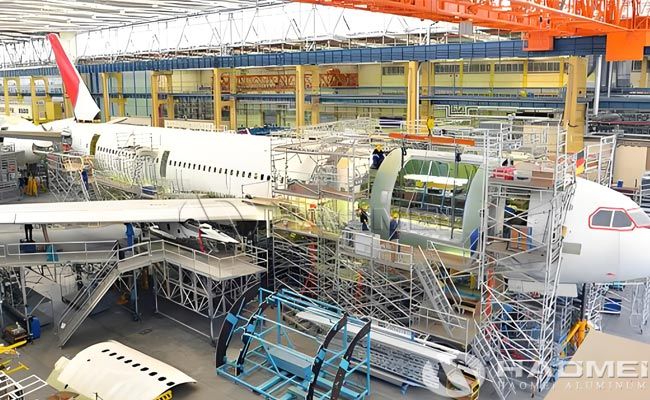
![]() Home > News
Home > News
Source:https://www.aircraft-aluminium.com/a/2024-airplane-aluminum-sheets.html
2024 airplane aluminum sheet is a core material in the aerospace industry. A member of the aluminum-copper-magnesium (Al-Cu-Mg) alloy family, it boasts excellent comprehensive performance.

1. Material Properties of 2024 Airplane Aluminum Sheets
- High Strength and Lightweight
2024 aluminum alloy boasts a tensile strength of 425-520 MPa (T351 state), a density of only 2.73 g/cm³, and a specific strength (strength-to-weight ratio) of 125 MPa・cm³/g, far exceeding most structural steels. These properties make it an ideal choice for lightweighting aircraft structures. For example, the Boeing 737 wing skins utilize 2024-T351 aluminum sheet with a thickness of 1.2-6.0 mm.
- Fatigue Resistance
It performs excellently under cyclic loading, with a fatigue limit (10⁷ cycles) of 140 MPa, comparable to the aviation titanium alloy Ti-6Al-4V. It is suitable for areas subjected to alternating stresses, such as wing stringers and fuselage ribs.
- Processing and Weldability
After solution treatment, it exhibits excellent ductility and can be further strengthened through cold working and heat treatments (such as T3 and T6). Although it is prone to cracking during welding, specialized processes (such as friction stir welding) can achieve reliable connections. It is often used for riveted structural parts.
- Heat Resistance
It maintains high strength below 150°C, surpassing 7075 aluminum alloy. It is suitable for components close to the engine (such as landing gear links).
- Corrosion Resistance Limitations
It is highly susceptible to intergranular corrosion, requiring pure aluminum cladding or surface treatment (such as Alodine 1200S chemical conversion coating) to enhance its protection. Salt spray testing has shown that the protective system can withstand 2000 hours of substrate-free corrosion.
2. Common Tempers and Applications
- T3 (Solution Treatment + Cold Working + Natural Aging)
Characteristics: Balanced strength and toughness, high processing precision.
Applications: Moderately stressed structural components such as wing leading edges and fuselage frames.
- T351 (Solution Treatment + Tensile Straightening + Natural Aging)
Characteristics: Internal stress relief, excellent dimensional stability.
Applications: Boeing 737 wing skins, fuselage bulkheads, and other major load-bearing components, with a thickness range of 0.25 inches and above.
- T81 (Solution Treatment + Cold Working + Artificial Aging)
Characteristics: Highest strength state, with increased hardness but slightly reduced ductility.
Applications: Ultra-high stress applications such as missile hulls and landing gear struts.
- O (Annealed State)
Characteristics: Completely softened, with optimal formability.
Applications: Preforms for complex curved skins.
3. Core Advantages
- Balanced Comprehensive Performance
2024 aluminum alloy strikes a balance between strength, fatigue resistance, and machinability, particularly outperforming 7075 aluminum below 150°C, making it a signature material for early jet aircraft (such as the Boeing 707).
- Mature Supply Chain Support
Major global aluminum fabrication companies have stable production capabilities, and their products comply with international standards such as AMS 4037 and QQ-A-250/4, with a mature supply chain.
- Outstanding Cost-Effectiveness
Compared to 7000-series aluminum alloys (such as 7055), 2024's manufacturing cost is approximately 15%-20% lower, and its processing is simpler, making it suitable for large-scale applications.
4. Market Share and Industry Position
- Dominant Position in the Aviation Sector
2024 aluminum represents the 2xxx series of aluminum alloys, accounting for 30%-40% of the global aircraft aluminum sheet market share, primarily used in structural components such as fuselages and wings. For example, a single Boeing 737 uses approximately 12 tons of 2024 aluminum plate, accounting for 25% of its total aluminum usage.
- Competitive Landscape
Advantages: It remains irreplaceable in the market for primary structural parts below 150°C, particularly in traditional civil airliners and military transport aircraft.
Challenges: 7000-series aluminum alloys (such as 7055) are gradually penetrating ultra-high-strength applications (such as wing spars), while aluminum-lithium alloys (such as 2195) are partially replacing 2024 aluminum in new-generation wide-body aircraft (such as the Boeing 787).
5. Market Response and Technology Trends
- User Reviews
Advantages: Its high strength, weldability, and mature processing make it the "default choice" for aviation manufacturers. For example, the Airbus A320 series has long used 2024-T351 aluminum plate.
Improvement Needs: Some users have reported that its corrosion resistance needs improvement, especially in hot and humid environments, requiring enhanced protective coatings.
- Technological Innovation
Surface Treatment: Plasma Electrolytic Oxidation (PEO) ceramic coating technology can increase corrosion resistance by more than three times and has been applied to the domestically produced C919 fuselage skin.
Green Manufacturing: China Aluminum Research Institute's 2024 patented technology reduces production energy consumption by 12% through optimized solid solution processing, while also improving paint strength and intergranular corrosion resistance.
2024 airplane aluminum sheet, with its high strength, fatigue resistance, and mature process, holds an irreplaceable position in the aviation structural parts market. Despite competition from new aluminum alloys, its comprehensive performance and cost advantages will ensure its mainstream position over the next decade. With advances in surface treatment technology and recycled aluminum processing, 2024 aluminum alloy will further consolidate its core role in the aerospace and high-end manufacturing sectors.